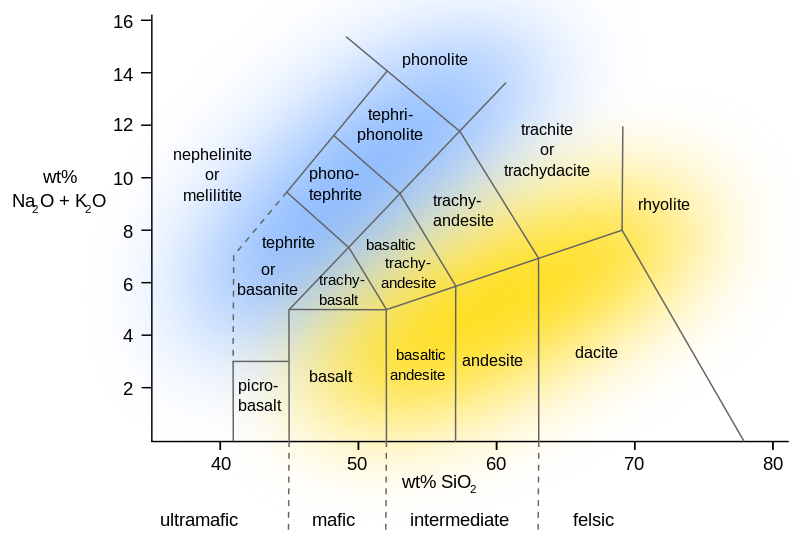Difference Between Mafic and Felsic

Classification extrusive rocks
Mafic vs Felsic
In the concept of mineralogy, or geology in the much broader sense, two terms are commonly used to describe the characteristics of rocks and also lava. These terms are mafic and felsic.
1. Runny or sticky
When used to describe the characteristics of lava, mafic lava would mean that it is runnier or more viscous as opposed to the felsic lava.
The reason for such is the amount of silica present in the lava. In mafic lavas, there is less silica than in felsic. With a runnier lava, the volcanic eruption is most likely not that violent as exemplified in the Hawaiian Island volcanic eruptions.
2. Origins & endings:
Moreover, mafic lava is responsible for the rock formation known as basalt. If you carefully examine the floor of the ocean, you shouldn’t be surprised that most of it is made of basalt. It is also connected to the nature of mid-ocean ridges as well as interplate volcanism.
By contrast, felsic lava is usually found in specific geological areas known as the convergent zone. This area is where geologic plates collide. Because of the presence of huge amounts of silica in this area, and the addition of the surrounding water and burnt earth, the combination creates stickier lavas and more violent eruptions. Felsic lava produces andesitic and rhyolite rock formations.
3. Silica:
The terms ‘mafic’ and ‘felsic’ while having some connection with their mineral constituents:
Mafic from Magnesium and ferrous/ferric. Felsic from feldspar (rock) and Silica, it is the silica content which shapes the difference.
As such, igneous rocks are described based on their silicate minerals. Arranged by way of increasing silica content, igneous rocks can be described as being ultramafic, mafic, intermediate, and felsic. This means that ultramafic is the type of rock having the least silica while felsic has the most silicate compound.
Ultramafic up to felsic means an increase in lightness of color. Thus, ultramafic rocks are the darkest in color while felsic rocks are the lightest. To explain this, geologists claim that the mafic’s dark appearance is attributed to the coexistence of magnesium and iron. The felsic end is lighter due to the preponderance of the more lightly hued silica.
Summary:
1.Mafic lava is more viscous than felsic lava.
2.Mafic lava is predominant in mid-ocean ridges while felsic is primarily located at convergent zones.
3.Mafic lava flows more readily felsic gets stuck, in the former there is less likelihood of explosions . Felsics’s tendency to cap steam and other gases means eruptions of an explosive nature are more likely
4.Mafic lava creates basalt while felsic lava produces andesitic and rhyolite rocks.
5.Either in describing rocks or lava, mafic means that the lava or rock has less silica while felsic implies that the lava or rock has the most silica.
6.Mafic rocks are darker in color than felsic rocks.
- Difference Between Plant Protein and Animal Protein - March 7, 2024
- Difference Between Crohn’s and Colitis - March 7, 2024
- Difference Between Expression and Equation - March 7, 2024

Thank you. This is most well-written, understandable answer to this question. The info. was very helpful.
M
i didnt undersant
in the 2nd paragraph, it states that mafic lavas are runnier and more viscous, shouldn’t it be if it is “runnier” that it would be LESS viscous. Please respond.
i agree
Viscous means resistance to flow! The more mafic the LOWER the viscosity (it is runnier) the more felsic the HIGHER the viscosity (it is stickier).
Very, very, very helpful
Thank you